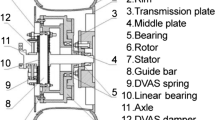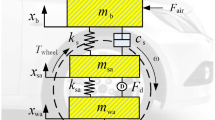Abstract
To overcome vertical vibration negative effects induced by high unsprung mass of the existing IWM, a novel integrated IWM topology scheme is developed. This scheme aims for the integrated design of hub, rotor housing and brake disk, and the stator is considered as a DVA, which is flexibly isolated from the unsprung system by the suspension elastic sleeve. Primarily, the quarter-vehicle dynamic model with the DVA-based electric wheel is established, and the improved vibration transmission characteristics of the integrated IWM are clarified in the frequency domain. Then, according to the sensitivity analysis theory, the sensitivity of the vertical dynamic response to the association structural parameters such as stator mass, stiffness and damping of rubber bushing and bearing is discussed. On this basis, the MCO of the association structural parameters is carried out by using the adaptive weighted PSO and FEM. After optimization and treatment, the overall mass of stator decreases by 9.35% when the structure strength is satisfied, the vertical dynamic characteristics of the integrated IWM system have been improved to varying degrees; particularly, the motor MGD gets more than 20% improvement. The results demonstrate that the proposed integrated scheme can observably improve the vehicle vertical dynamics and simultaneously the DVA system exhibits excellent performance in terms of wheel and motor vibration suppression.












Similar content being viewed by others
Abbreviations
- BVA:
-
Body vertical acceleration
- DVA:
-
Dynamic vibration absorber
- EVs:
-
Electric vehicles
- FEM:
-
Finite element method
- IWM:
-
In-wheel motor
- MCO:
-
Multi-objective collaborative optimization
- MGD:
-
Magnet gap deformation
- PSO:
-
Particle swarm optimization
- RMS:
-
Root mean square
- RSR:
-
Road surface roughness
- RWDL:
-
Relative wheel dynamic load
- SDD:
-
Suspension dynamic deflection
- VNE:
-
Vertical negative effects
References
Profumo F, Zhang Z, Tenconi A (1997) Axial flux machines drives: a new viable solution for electric cars. IEEE Trans Ind Electron 44(1):39–45
Hori Y (2004) Future vehicle driven by electricity and control research on four-wheel-motored “UOT electric March II”. IEEE Trans Ind Electron 51(5):954–962
Rauh J, Ammon D (2011) System dynamics of electrified vehicles: some facts, thoughts, and challenges. Veh Syst Dyn 49(7):1005–1020
Murata S (2012) Innovation by in-wheel-motor drive unit. Veh Syst Dyn 50(6):807–830
Purdy DJ, Simmer D (2004) A brief investigation into the effect on suspension motions of high unsprung mass. J Battlefield Technol 7(1):15–20
Van Schalkwyk SDJ, Kamper MJ (2006) Effect of hub motor mass on stability and comfort of electric vehicles. In: IEEE VPPC 4211325
Chukwuma JI, Barrie CM, Simon TMB et al (2013) Fault-tolerant in-wheel motor topologies for high-performance electric vehicles. IEEE Trans Ind Appl 49(3):1249–1257
Lovatt HC, Ramsden VS, Mecrow BC (1998) Design of an in-wheel motor for a solar-powered electric vehicle. IEE Proc Electr Power Appl 145(5):402–408
Johansen PR, Patterson D, O’Keefe C et al (2001) The use of an axial flux permanent magnet in-wheel direct drive in an electric bicycle. Renew Energy 22(1):151–157
Yang YP (2004) Design and control of axial-flux brushless DC wheel motors for electric vehicles-part I: multi-objective optimal design and analysis. IEEE Trans Magn 40(4):1873–1882
Nagaya G, Wakao Y, Abe A (2003) Development of an in-wheel drive with advanced dynamic-damper mechanism. JSAE Rev 24(4):477–481
Zhao YE, Zhang JW, Han X (2008) Design and study on the dynamic-damper mechanism for an in-wheel motor individual drive electric vehicle. Mech Sci Technol Aerosp Eng 27(3):395–398 (in Chinese)
Luo YT, Tan D (2012) Study on the dynamics of the in-wheel motor system. IEEE Trans Veh Technol 61(8):3510–3518
Chen XB, Yin J, Wang W et al (2016) Approaches to diminish large unsprung mass negative effects of wheel side drive electric vehicles. J Adv Mech Des Syst 10(4):JAMDSM0064
Cvetkovski GV, Petkovska LB (2009) Weight reduction of permanent magnet disc motor for electric vehicle using genetic algorithm optimal design procedure. IEEE EUROCON 2009:881–888
Lei F, Bai YC, Zhu WH et al (2017) A novel approach for electric powertrain optimization considering vehicle power performance, energy consumption and ride comfort. Energy 167(C):1040–1050
Lassaad Z, Ali M, Hafedh T (2017) Particle swarm-based optimization of an in wheel permanent magnet motor. In: 14th International multi-conference on systems, SSD, pp 138–144
Takahashi T, Takemoto M, Ogasawara S et al (2017) Size and weight reduction of an in-wheel axial-gap motor using ferrite permanent magnets for electric commuter cars. IEEE Trans Ind Appl 53(4):3927–3935
Luo YT, Tan D (2013) Lightweight design of an in-wheel motor using the hybrid optimization method. Proc Inst Mech Eng Part D J Autom Eng 227(11):1590–1602
Tan D, Song F, Wang Q (2018) Design and optimization of the in-wheel motor driving electric vehicle based on the vibration energy transmission. IEEE Trans Veh Technol 24(21):5129–5140
Ahmet Y (2019) Optimum suspension design for non-linear half vehicle model using particle swarm optimization (PSO) algorithm. In: 41st International JVE conference, vol 27, pp 43–48
Wang W, Niu M, Song YL (2019) Integrated vibration control of in-wheel motor-suspensions coupling system via dynamics parameter optimization. Shock Vib 3702919:1–14
Liu MC, Gu FH, Zhang YZ (2017) Ride comfort optimization of in-wheel-motor electric vehicles with in-wheel vibration absorbers. Energies 10(10):1647
Liu MC, Gu FH, Huang JH et al (2017) Integration design and optimization control of a dynamic vibration absorber for electric wheels with in-wheel motor. Energies 10(12):2069
Acknowledgements
This research was supported by the Scientific Research Foundation of Shandong University of Science and Technology for Recruited Talents (Grant No. 2017RCJJ053) and Key R&D project of Shandong Province (Grant No. 2016GGX105008).
Author information
Authors and Affiliations
Corresponding author
Additional information
Technical Editor: Wallace Moreira Bessa.
Publisher's Note
Springer Nature remains neutral with regard to jurisdictional claims in published maps and institutional affiliations.
Rights and permissions
About this article
Cite this article
Wang, Q., Li, R., Zhu, Y. et al. Integration design and parameter optimization for a novel in-wheel motor with dynamic vibration absorbers. J Braz. Soc. Mech. Sci. Eng. 42, 459 (2020). https://doi.org/10.1007/s40430-020-02543-8
Received:
Accepted:
Published:
DOI: https://doi.org/10.1007/s40430-020-02543-8




